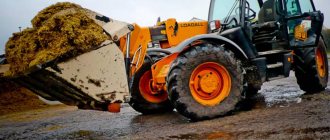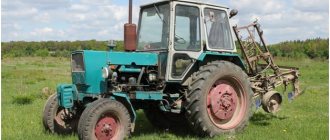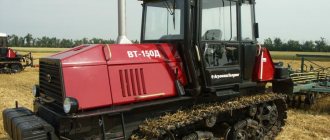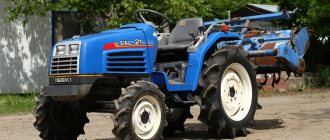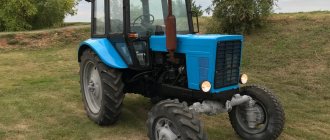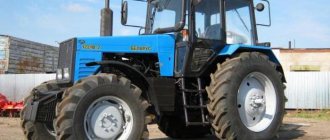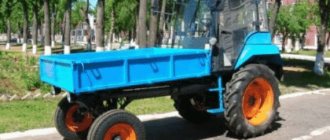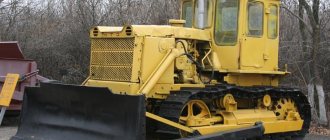general information
YuMZ-6 is a representative of universal wheeled tractors for general purpose, part of the “Belarus” line, initially produced by the tractor plant in Minsk, but later developed at YuMZ. Types of work and operations permitted for the tractor:
- agricultural activities using semi-mounted, mounted devices, multifunctional trailers;
- Men at work;
- construction;
- forestry operations;
- other types of special work;
- drive functions for stationary and mobile units;
- transportation on trailers.
An individual line of mounted units has been created for the YuMZ-6, adding various functionality to the tractor necessary for certain jobs. The car can be transformed into:
- earth mover;
- loader;
- bulldozer;
- excavator, etc.
Thanks to its successful design and ease of maintenance, the tractor can be converted both at the factory and in a specialized workshop on site.
This is interesting: VTZ-30SSh Agromash - technical characteristics
The lineup
From the model range we can highlight:
- Modification YuMZ-6L. The prototype of this model is the MTZ-50 tractor.
- YuMZ-6AK. The tractor featured a cabin with improved visibility. The installation of a PTO at YuMZ significantly expanded the functionality of the attachments.
- Model YuMZ-6AL. The tractor had an adjustable steering rack, a modified brake system, an updated dashboard and a modified hood.
- Modification of the YuMZ-6KL excavator. Model 6KL is presented in industrial version. The tractor is equipped with standard mounting blocks for bulldozer and excavator equipment, and the hydraulics and hydraulic system have been significantly strengthened.
In addition to Soviet modifications, there is also the Volvo BM-700 model. In 1974, the USSR sold design documentation for the YuMZ-6 to Sweden, where they developed an improved version of the tractor for the domestic market.
Subsequently, after the YuMZ-6KL tractor, the development of the model range was continued by modernized and modern models: ZTM-60 (since 1993), ZTM-82L (since 1994), YuMZ-8271/8280 (since 1998), YuMZ-10280 (since 2000), YuMZ-8070/8080 (since 2003).
The most common YuMZ excavator is EO 2621A. This model can still be found on any construction site today.
Story
The YuMZ-6 tractor was produced at the Southern Machine-Building Plant (Dnepropetrovsk, now Dnepr, Ukraine).
The decision to build a car plant in Dnepropetrovsk was made after the liberation of the city in the summer of 1944. It was planned to produce GAZ-51 trucks, but then they “changed their minds”. DAZ switched to assembling the ZIS-150. In 1951, DMZ became “mailbox No. 186”, received secret No. 586 and began manufacturing ballistic missiles designed by S. Korolev, as well as other military equipment. Truck production was curtailed. Later, DMZ became part of the Yuzhmash Production Association.
In 1953, to cover the production of intercontinental missiles, a legend was developed (as for all closed factories of the USSR), according to which in 1954 the DMZ began producing general-purpose tractors. (They were considered a by-product. However, the production of equipment at a numbered plant, from its spare parts, which went through the same military quality control department for all conveyors, determined the high quality of the YuMZ-6). The first-born was MTZ-2 (1954-1958), assembled from Belarusian components. Then - MTZ-5 (1958 - 1972). This model has already been developed jointly by specialists from MTZ (Minsk) and DMZ. The tractor was subsequently named YuMZ-5, but the Belarus trademark remained with it (this was one of the elements of the cover story). In 1966, plant No. 586 was renamed YuMZ.
The first YuMZ-6 rolled off the assembly line in 1966. The tractor began to be produced serially in 1970. Despite the fact that the model was created on the basis of MTZ-5, and retained the continuity of the design, it is already considered YUMZ’s own product, which is simply very similar to the equipment assembled in Minsk. Since that time, YuMZ and MTZ have been two different brands. This feature was also evident in the approach to design. If Belarusian models became more and more complicated, then YuMZ engineers installed components on their brainchild that were easily removed and repaired in the conditions of a collective farm workshop. It was the simplest and most reliable Soviet tractor.
In 1972, YuMZ-6L/6M was recognized as the best tractor of the past year. In 1974 – received the Quality Mark. At the same time, the documentation for YuMZ-6 was sold to the Swedes, who, after deep modernization, produced Volvo BM-700 based on it from 1976 to 1982.
Purpose
The YuMZ unit belongs to the famous Belarus line of machines. The scope of his activities includes the following types of work:
- movement of goods;
- digging trenches and pits;
- loading and unloading operations;
- transportation of soil to the dump;
- formation of embankments;
- clearing areas of snow and debris;
- plowing of agricultural land;
- milling and loosening the soil;
- sowing crops;
- watering plants;
- fertilization;
- harvesting.
Tractor Yumz 6, general view
Dimensions
Let's consider the dimensions of the YuMZ-6 tractor, as well as how much the YuMZ EO 2621 excavator, equipped with a blade and a backhoe bucket, weighs.
Dimensions of the YuMZ-6 tractor:
- length - 4.165 m;
- width - 1.88 m;
- height - 2.49 m.
Weight is 3400, 3700, 3900 kg.
The weight of the trailer permissible for its operation in tandem with YuMZ-6 is 6 tons.
The EO 2621 excavator, created on the basis of the YuMZ-6AK tractor, has the following parameters:
- length - 6.9 m;
- width - 2.3 m;
- height - 3.8 m.
Machine weight - 5600 (±10) kg.
Parameters of attachments for the EO 2621 excavator
- The backhoe has a bucket capacity of 0.25 m3, a maximum digging radius of 5.2 m, a digging depth of 4.15 m, and a maximum unloading height into a vehicle of 3.7 m.
- Bulldozer blade with a working width of 2 m and a cutting depth of 0.15 m.
The weight of the YuMZ excavator unit without a tractor will be 1.7 tons.
Modifications
During the period of time that the Southern Machine-Building Plant produced the YuMZ-6 tractor, various modifications created on the basis of the basic model were available to consumers.
There were four in total:
The power unit of models whose names included the letter “L” was started using a starting engine (if instead of the letter “L” the letter “M” appeared, this meant that the engine was started by an electric starter). The “K” in the model name indicated that the tractor was equipped with a cabin with increased dimensions.
Photo source: Rosselkhoz.rf Photo YuMZ-6
Separately, I would like to highlight the YuMZ-6K model, which was originally planned to be used for industrial purposes. In this regard, the plant decided to abandon the agricultural attachments (located at the rear), installing instead mounts for a bulldozer blade and an excavator bucket. When the basic YuMZ-6 tractor was discontinued, this modification, however, took its place in agricultural use.
Device
The basis of the YuMZ machine is a frame consisting of side members and a transverse beam. The front part is equipped with an axle with small diameter wheels. They are controlled by trunnions. A drive to the drive axle is mounted at the rear of the tractor. To ensure good cross-country ability, the machine is equipped with low-pressure tires. The tractor is equipped with the following systems:
- separate hydraulic system;
- electrical equipment designed for a 12 volt network;
- air supply system;
- a mechanism that ensures the operation of rear linkage equipment.
The steering device is equipped with a hydraulic booster, which ensures comfortable control of the unit. The braking system is represented by shoe and disc type mechanisms.
dimensions
YuMZ-6 – mid-size universal tractor:
| Length | 4.165 m with attachment |
| 3.69 m without attachment | |
| Width | 1.884 m. |
| Tractor height | 2.66 m on the roof |
| 2.86 m along the muffler | |
| Wheelbase | 2.45 mu |
| Clearance | 45 cm. |
| How much does the YuMZ 6 tractor weigh? | 3.35 t. – net weight, excluding technical fluids |
| 3.89 t. - operational | |
| 6 t – permissible weight of the YuMZ tractor trailer | |
| 1.15 t. – permissible weight of additional equipment | |
| Travel speed | Up to 24.5 km/h. |
The main characteristics are given, which may vary somewhat depending on the specific modification. All tractor models have a well-thought-out weight distribution, thanks to which the machines are passable and very maneuverable. YuMZ-6 can be used in confined spaces - forest clearings, in industrial and agricultural buildings, etc.
The weight of the YuMZ 6 series tractors is similar (in basic configurations).
Cabin
Typical view of the YuMZ-6 cabin:
It is reliable and simple, with sufficient control comfort and informative dashboard. Panoramic windows provide the tractor driver with good visibility, and rubber shock absorbers protect against vibration.
The tractor cabin contains:
- height-adjustable, spring-loaded chair;
- steering column;
- control levers;
- brake and clutch pedals;
- instrument panel, including pneumatic and oil pressure sensors, speedometer, and on-board power current indicators.
For the convenience of the operator, a heating system is provided, there is also a box for a first aid kit, and a thermos is included in the standard equipment of the tractor.
Attachments
For the YuMZ-6, many attachment positions have been developed for various purposes - there are 258 options for possible “body kit”. Main types of body kit:
- plows, harrows, cultivators, other types of agricultural implements;
- compressors, welding machines, and other general-purpose equipment;
- trailers;
- earthmoving equipment, etc.
Excavator version based on the YuMZ machine. The YuMZ 6 excavator tractor can weigh up to 3.9 tons, depending on the kit:
The equipment (except for the bulldozer bucket) is mounted on the rear linkage (in addition to some samples of the industrial version of the YuMZ-6K, which will be discussed below). The tractor linkage mechanism is equipped with a hydraulic cylinder drive, which makes it possible to move mounted units along a vertical axis. And the functioning of the units themselves is ensured by the transmission of torque through the PTO and additional devices for connecting pneumatic, hydraulic and electrical equipment to the tractor’s on-board networks.
The hitch is designed so that the tractor driver can independently connect the devices and operate them. The SA-1 towing device, controlled by a remote control in the operator’s cabin, helps with this. Thanks to this, work productivity increases and the need for assistants disappears.
This is interesting: MTZ-320 video: review of the model and attachments
Engine
The manufacturer installed a 4-stroke, 4-cylinder, water-cooled diesel engine without turbocharging on the wheeled YuMZ-6. The basic model of the tractor was equipped with two different models of power units: D-65 and D-242-71.
| Engine D-65 | |
| Engine power | 45.6 kW (61.9 hp) |
| Rated speed | 1,750 rpm |
| Torque (maximum value) | 270 Nm |
| Cylinder diameter | 11 cm |
| Fuel consumption | 245 g/kWh |
| Working volume | 4.94 l |
| Piston stroke | 13 cm |
The D-242-71 power unit was distinguished by higher performance indicators. Both engine models were characterized by high reliability.
| Engine D-242-71 | |
| Engine power | 46 kW (62.5 hp) |
| Rated speed | 1,800 rpm |
| Torque (maximum value) | 241 Nm |
| Fuel consumption | 226 g/kWh |
| Cylinder diameter | 11 cm |
| Piston stroke | 12.5 cm |
| Working volume | 4.75 l |
The fuel tank of the YuMZ-6 tractor holds up to 90 liters of diesel fuel. The maximum operating speed when moving forward is 11.1 km/h, the maximum transport speed (forward) is 24.5 km/h. When the YuMZ-6 is moving in reverse, the maximum speed is 5.7 km/h. The turning radius of the machine is 5 m.
Powertrain, transmission and hydraulics
The power units of YuMZ excavators are represented by four-stroke engines. Among them we can highlight:
- D-65 engine with an installed power of 60 horsepower, in addition to the engine a starter unit was installed;
- engine D-242-71 with a power of 71 horsepower.
The engine capacity of the D-65 is 4.95 liters. Engine capacity D-242-71 is 4.75 liters. The technical characteristics of the power units regulate the crankshaft rotation speed, which is 1,800 revolutions per minute.
The YuMZ excavator has a 5-speed gearbox, which is equipped with a dry clutch. The drive shaft and power take-off shaft are connected to each other. The box parts are lubricated by spraying oil. The gearbox is controlled using the gear shift lever and the lock lever. The technical characteristics of the transmission guarantee a speed of 24.5 km/h and overcoming inclines at an angle of 10°.
The YuMZ excavator (cockerel) loader has an aggregate-type hydraulic system, which consists of the following components:
- Oil TANK, which serves as a reservoir for hydraulic fluid. Located on the left side for better control of the oil level. This is convenient for the tractor driver.
- Hydraulic distributor - 2 pcs. The hydraulic circuit implies the presence of a fluid flow distributor for better control of excavator mechanisms.
- Gear pump. The hydraulic circuit is equipped with standard pumps of the NSh-71 and NSh-100 types. The pumps are driven through a splined coupling from the transmission gear. The pump gears are cast integrally with the shafts.
- Hydraulic cylinders. Hydraulic power cylinders raise and lower the bucket and blade of the YuMZ EO excavator. The cylinders are secured using brackets.
- High pressure pipes and hoses are necessary to supply oil to the components of the EO 2621 hydraulic system.
For better control, the YuMZ 6 tractor is equipped with power steering. The power steering drives the NSh-10 pump.
Attachments
The tractor was initially designed as a universal machine, capable of working with trailers, agricultural and industrial attachments.
Attachments adapted to the tractor are divided into three categories:
- agricultural equipment – seeders, plows, cultivators, harrows;
- construction equipment - compressors, welding systems, lifts, etc.;
- transport equipment – trailers, carts, tanks.
The attachment is interfaced with the tractor through the following elements:
- power take-off shaft of the power unit;
- retainer;
- towing unit SA 1, equipped with a control unit installed in the cabin.
The tractor is equipped with systems that allow you to connect electrical, hydraulic and pneumatic devices. The ability to work with attachments and transport equipment significantly expands the capabilities of the machine and its scope of use.
Excavator EO technical specifications
In order to analyze in more detail the simplicity of this excavator, let's consider its technical characteristics and the performance of the most common working element - the backhoe bucket.
| Specifications | |
| Rated motor power | 44(60) kW (hp) |
| Movement speed | 0.58-5.3 (2.1 - 19.0) m/s (km/h) |
| Length in transport position | 6.48 m |
| Width, excavator EO-2621 | 2.2 m |
| Transport height | 3.8 m |
| Front wheel track | 1.46 m |
| Rear wheel track | 1.55 m |
| Ground clearance | 0.4 m |
| Front tire pressure | 1.7-0 18 (1.7-1.8) MPa (kgf/cm2) |
| Rear tire pressure | 0.19-0.2 (1.9-2.0) MPa (kgf/cm2) |
| Structural mass | 5300 kg |
| Angle of rotation of working equipment | 28 (160) (in plan), rad(deg) |
| Hydraulic system pressure | 10 and 7.5 MPa (100 and 75) (kgf/cm2) |
| Nominal capacity of the working fluid tank | dm3 100 |
| Backhoe operating parameters | |
| Bucket capacity | 0.25 m3 |
| Bucket capacity | 475 kg |
| Bucket width | 0.76 m |
| Maximum digging depth | 3m |
| Largest digging radius | 5 m |
| Maximum unloading height | 2.2 m |
| Maximum digging force | 2570 kgf |
It is important to emphasize that the EO 2621, whose technical characteristics are as productive as possible, is capable of effectively performing its work functions in a wide variety of conditions. Its hydraulics can withstand staggering sub-zero temperatures, down to -40°, as well as extreme heat up to +40°, and still function properly.
Engine characteristics
The power and torque produced by the power plant is quite sufficient for its use in many areas, from agriculture, construction to maintenance in the urban and public sector.
- Volume 4940 cm³;
- Cylinder block, material – cast iron;
- Engine, type – in-line, four-stroke;
- Fuel system – direct injection;
- Cylinders, quantity, pcs. - 4;
- Cylinder operation, order: 1-3-4-2;
- Valve, quantity, pcs. - 8;
- Cylinder, diameter, mm – 110;
- Piston, stroke, mm. – 130;
- Compression, degree – 17.3;
- Crankshaft, nominal rotation speed min -1 – 1750;
- Fuel – diesel fuel;
- Air cleaner – combined (dry centrifugal and oil inertial-contact cleaning);
- Power kW/hp – 45.6/60;
- Torque moment, Nm – 221;
- Weight (dry engine), kg. – 540;
- Lifetime before major repairs, m.h. – 12000.
To prevent the motor from overheating, it was equipped with water cooling. When working with an average load, the power unit consumed approximately 9 liters, using a tank of 90 liters, the motor is capable of ensuring the operation of attachments for 10 hours, depending on the type of activity and load.
Kinematic and hydraulic diagram of the EO 2621 excavator
a - kinematic; b - hydraulic; 1, 20 and 22 - pumps; 2 and 21 - gearboxes; 3 - tank; 4 - unloading valve; 5, 6 and 8 - distributors; 7 - bypass valve; 9 — controlled check valves; 10 - needles; 11 — bulldozer hydraulic cylinder; 12 and 13 — hydraulic cylinders of outriggers; 14 and 16 — hydraulic cylinders of the turning mechanism; 15 - check valve; 17 — bucket hydraulic cylinder; 18 — hydraulic cylinders of the handle; 19 — boom hydraulic cylinder.
Other positive features that the 2621 excavator has include the following:
- – functional unpretentiousness, ease of maintenance, availability and low cost of spare parts;
– comparative efficiency of using fuel resources (when compared with other types of similar excavators);
– highest mobility;
– the ability to quickly change any working elements;
– small size, which makes it possible to effectively use this excavator in limited conditions and on unstable soils;
– ease of control of the working elements and the wheelbase itself.
As for the individual technical characteristics of the working base of the EO 2621 excavators, they can be viewed in the section where specific models are described in detail. But for the sake of fairness, it should be noted that previously excavators based on YuMZ were more common, but today you can increasingly see MTZ equipped with a bucket and blade. Although YuMZ-6 and MTZ-82 have the same traction class of 1.4, modern models of the Minsk Tractor Plant more meet the requirements of the “new time” and are more popular among consumers. As for specific manufacturers of EO 2621 excavators, there are quite a lot of them. Today they are assembled both at small specialized enterprises with a short assembly cycle, and at large factories, such as the Chelyabinsk Tractor Plant.
The EO 2621 excavator, the price of which in most cases does not exceed a million, is primarily a budget excavator
. Compared to other similar types of special equipment, it has the lowest price, but at the same time is not inferior to its competitors in performance characteristics.
The YuMZ-6 excavator is built on the basis of a tractor of the same name, produced from 1970 to 2001 by the Southern Machine-Building Plant. Wheeled vehicles were intended for agricultural work. During production, several modifications of the YuMZ-6 were produced, including the YuMZ-6KL excavator.
LTZ-60
The LTZ-60 tractor is a multi-purpose machine, produced at the Lipetsk Tractor Plant. This tractor was created on the basis of the previous model and became a kind of replacement for the T-40 tractor. The LTZ-60 has gained particular popularity in the field of agriculture, but it is worth noting that the operation of the tractor is also in demand for construction work.
Also, state tests were carried out on the first models of the tractor, during which this tractor showed its fairly high efficiency in performing various works. If we compare the LTZ-60 and the no less popular model in this class, the MTZ-80, then the Lipetsk machine is quite economical and has a lower cost, both for the tractor itself and for its spare parts. LTZ-60 refers to 1.
Class 4 traction equipment.
Purpose
The LTZ-60 tractor is intended for carrying out a lot of different work in agriculture, namely, it is intended for plowing the soil, cultivating, harrowing, preparing the soil for sowing, sowing and harvesting. In addition to this, this tractor also performs necessary tasks in construction, where it is used mainly for loading and transporting goods, as well as for some earth-moving work.
Modifications
The LTZ-60 tractor, like many other tractors, has its own modified versions. Over all the years of production, the following modifications have been developed and released:
- Modification LTZ-60A. In fact, it is a basic version of the tractor, but whose power unit has been replaced. The new engine model has a smaller volume compared to the first one, namely 4.15 liters, however, the maximum power has not changed and is also 60 horsepower. The remaining technical elements remained without any changes. This modification is capable of using mounted units weighing no more than 850 kilograms.
- Modification LTZ-60AV. It differs from the previous modification in improved maneuverability, which was obtained by improving the hydraulic power steering. The interior equipment of the tractor remains the same, with the exception of the expansion of the cabin space. By replacing the metal cabin body with a fiberglass one, the weight of the tractor was significantly reduced, which had a positive effect on its maneuverability. An autonomous heater was also added, thanks to which it is possible to operate the tractor in various weather conditions without feeling discomfort. This version was released from 1994 to 1995.
- Modification LTZ-60AB. It is the latest and also the best version compared to the others. When developing this modification, the designers took into account all the technical shortcomings present in previous modifications. The lifting capacity of the hydraulic system has been slightly increased, as a result of which this version of the tractor is capable of using mounted units weighing no more than 900 kilograms. The previous model of the power unit was replaced with an engine from the Minsk Motor Plant D-248. This allowed the tractor to achieve 235 Nm of torque. But it is worth noting that this engine has less power, namely 57 horsepower. A sintered metal clutch was added to the tractor transmission. The gearbox is also mechanical, but has seven gears. Also, thanks to the introduction of a lot of changes, the tractor has the opportunity to use absolutely all types of additional attachments.
Peculiarities
The tractor can boast of the reliability of all its components and mechanisms, withstanding heavy loads without the occurrence of technical problems. The tractor itself is easy to maintain, so finding a problem with any mechanism will not be difficult. It is worth noting that spare parts for this tractor have a low price, which is also a very important parameter.
High cross-country ability and maneuverability allow the tractor to do various types of work in places that are difficult to reach for any other special equipment. The cabin has glazing made of heat-absorbing materials that allow you to maintain the temperature inside the cabin regardless of the environment. The cabin is also equipped with a heater, allowing you to carry out the necessary work in cold weather conditions without feeling discomfort.
Price new and used
Currently, you can purchase an LTZ-60 tractor in new technical condition from one million to two million Russian rubles. The year of production, additional equipment and modification version directly affect the cost of the machine. But it is worth noting that in comparison with other tractors of the same class, the LTZ-60 has a lower price, high reliability and maintainability.
The LTZ-60 tractor in used condition currently has a price range from 250 thousand to 380 thousand Russian rubles. Just like the cost of a new machine, the used version is influenced by the year of production, additional equipment (internal or technical), modification version, equipment (in which this tractor was previously purchased) and, of course, the condition of the tractor itself.
Operation and equipment
An excavator based on YuMZ 6 is adapted to work in a wide temperature range, is reliable and universal in use. It handles the heat and starts perfectly at -40°C.
The design and layout of the excavator allows it to be used for various construction works.
Modernization and alteration make it possible to expand the range of trailed and mounted equipment.
An example is a quick-hitch front loader.
Loader technical specifications:
- lifting height - 4m;
- time for replacing the working body is 1-4 minutes;
- knife thickness - 20mm;
- bucket thickness - 4mm;
- the thickness of the linings is 10mm.
The loader is designed to work with various loads (sand, grain, crushed stone, etc.), and is equipped with quick-release fasteners, which significantly reduces the time of its installation and dismantling.
Main indicators and operating parameters:
- working width - 2m;
- loading angle - 80°;
- work productivity - 45t/hour;
- rated load capacity - 8 kN;
- weight - 0.87t.
Distinctive features - all finger connections of the device are equipped with oil nipples, and all high-pressure hoses have European standard connectors. A more detailed description, the design of the excavator and the intricacies of operating the excavator can be found in the operating instructions.
The YuMZ 6 excavator continues to collect only positive reviews.
If you own an excavator based on the YuMZ tractor, what attachments do you most often use?
Tractor excavator
Mini-excavator with your own hands: from searching for drawings to the assembly process
Technical characteristics and modifications of the EO-4225 excavator
Technical characteristics and modifications of the Korean excavator EO-33211
Single-bucket wheeled excavator EO-3322
Technical characteristics of the advantages and disadvantages of the single-bucket excavator EO-2101
How does a tractor work?
The layout of the YuMZ-6 tractor model is classic for vehicles of this class with a 4x2 wheel arrangement. The supporting part of the equipment is a specially equipped half-frame. It is formed from a transverse beam and longitudinal spars. The clutch and gearbox housings are mounted on such a support frame.
Diagram of the front axle of the YuMZ-6 tractor
The front axle with steered wheels is attached to the front of the tractor using a swivel joint. Their movement is possible due to the presence of trunnions in the design. At the rear, the vehicle rests on axle sleeves that are rigidly connected to the gearbox housing. Such design features of the YuMZ-6 model ensure ease of control and reliability in operation. The drive of this tractor is permanent, carried out on the rear wheels.
A special feature of the vehicle is the presence of low-pressure pneumatic tires. They have excellent lugs, which ensures excellent maneuverability in all conditions. The tractor wheels have different diameters, which is an excellent technical solution.
Advantages and disadvantages
The YuMZ wheeled tractor has the following positive characteristics:
- high power level;
- good performance;
- economical engines;
- large selection of working equipment;
- simplicity of design;
- reliability of all systems;
- ease of repair and maintenance;
- unpretentiousness to fuel and lubricants;
- quality components.
The disadvantages include a rigid chassis, low speed of the power plant and the lack of a comfortable workplace.
General description and technical characteristics of the YuMZ-6 tractor
The layout of this model is classic for vehicles of this class with a 4x2 wheel arrangement. The skeleton of the YuMZ-6 tractor is a semi-frame, made up of two longitudinal spars and a transverse front beam. The clutch and gearbox housings are attached to this structure.
In the front part of the tractor, a front axle with steered wheels is hingedly mounted on the frame, the rotation of which is ensured by axles. At the rear, the car rests on axle sleeves rigidly attached to the gearbox housing. This design is the simplest and most reliable. The drive is permanent to the rear wheels through the axle shafts of the final drives.
The tractor is equipped with low-pressure pneumatic tires with developed lugs to ensure high maneuverability. The wheels have different diameters, the tire size in front is 7.50-20 or 9.00-20; rear – 15.5R38. This technical solution is typical for machines in this category and provides them with fairly high technical characteristics.
Tractors of the YuMZ-6 series belong to the 1.4 traction class, which makes it in demand in various fields of management. The machine is equipped with:
- separate-unit hydraulic system;
- electrical equipment with a 12 V on-board network;
- pneumatic system;
- rear linkage mechanism for equipment.
The steering of the tractor is equipped with a hydraulic booster; the rotation of the front wheels is ensured by a trapezoid through a longitudinal link. The latter is connected to the shaft of the three-spoke steering wheel through a cardan transmission. The service brake system is pneumatic, shoe or disc type with pedal control. The parking mechanism is activated by a lever secured by a ratchet.
The YuMZ-6AL tractor was produced from 1978 to 1986.
2.1 Dimensional and weight parameters
Tractors of the YuMZ-6 series belong to the category of medium-sized, universal machines.
The main mass and dimensional characteristics of the machine are as follows:
Dimensions:
Machine weight: |
The overall and weight characteristics of the YuMZ-6 tractor may differ from those indicated above, depending on the modification. The dimensions of the vehicle and rational weight distribution provide it with excellent maneuverability and maneuverability. Use in limited areas, in industrial and agricultural buildings, in forests and open spaces is allowed.
2.2. Tractor engine YuMZ-6
Tractors of the YuMZ-6 series are equipped with diesel power units of two models D65M and D65N, which have different structural weights of 525 and 540 kg, respectively. The engine is installed in the front part in front of the cabin and secured with rubber-metal supports on the frame. The power unit is covered from above and from the front by a hood; removable steel panels are installed on the sides. Main technical characteristics of the engine:
- Power unit power: nominal - 62 hp;
- operational - 60.5 l. With.;
- at the power take-off shaft - 57 hp. With..
- power – 7.36 kW;
The diesel engine is naturally aspirated without turbocharging, which greatly simplifies its design and operation. The power unit has a liquid cooling system with a front-mounted radiator. Fuel is supplied from a tank located behind the cabin and shielded from external influences by a steel sheet. The manufacturer guarantees a minimum engine life of 10 thousand hours before the first major overhaul.
2.3. Gearbox of the YuMZ-6 tractor
Tractors of the YuMZ-6 series are equipped with mechanical gearboxes, the latter are designed to change gear ratios, provide reverse movement and power take-off. The design allows the engine to operate with the tractor stationary and the clutch engaged.
The gearbox of constant gearing and three movable carriages has five stages with manual lever control. The unit is equipped with a reduction gearbox, which allows the number of modes to be doubled. The primary shaft, mounted on roller bearings, rotates the secondary or PTO shaft through a system of gears and clutches.
The design of the box eliminates the possibility of engaging two gears simultaneously through a special rocker. There is also a locking mechanism to prevent the engine from starting if the gearbox is not in neutral. The parts and components of the gearbox are lubricated with oil located in the crankcase by partially immersing the gears and spraying it.
2.4. Chassis and transmission of the YuMZ-6 tractor
The YuMZ-6 universal wheeled tractor is equipped with reliable mechanisms for transmitting and converting torque from the engine to the wheels. The chassis includes:
- Main clutch. Double, permanently closed with a dry sump, operating principle is frictional. In addition to the main clutch, there is a separate clutch mechanism for the PTO drive; the control of the main and additional devices is separate.
- Gearbox (described in detail above).
- The rear axle is in the crankcase, on which the main and final drives are installed, between which there is a differential.
The front wheels are mounted on fixed axles, which in turn are mounted on rotary axles. The bridge beam is telescopic, which ensures a wide range of track changes. The rear wheels are mounted on axle shafts supported by ball bearings installed in the final drive sleeves. The axle housing is filled with transmission oil, which provides lubrication of the mechanisms.
Description of the unit
The D 65 diesel engine is the basic power plant that is installed on various types of tractors. These machines have various applications; they can be used as tractors, bucket or trench excavators, bulldozers and other equipment.
The D 65 power plant has a large number of modifications:
- YuMZ tractors: D 65N, D 65M, D65NT, D 65 MT, D 65N1, D 65ND, D 65NT1, D 65LS;
- Tractor ZTM: D 65 MT1;
- Tractor LTZ: D65M1L.
All modifications of the units are of the same type, the only difference is in the mechanisms with which the design features of individual pieces of equipment and starting devices were modernized. Thus, the most popular and widespread diesel models D 65LS and D 65N differed from each other in the design of the flywheel housing, which had a mechanism including a front support drive gear, and in the design of the flywheel itself.
The characteristics of the base D 65 engine are common to all modifications. The power unit is a four-stroke, four-cylinder, piston engine in which the cylinders are arranged in a row, vertically. Diesel fuel is injected directly into the cylinder, and the air-fuel mixture is ignited by compression. Engine power 60 hp, speed 1500-2000 min -1.
The location of system units depends on the engine modification. Thus, brand D 65N equipment uses an additional starting motor as a starting device. The D 65M unit uses an electric starter to perform the starting function. The power supply equipment for both units is located on the right side. As for the dimensions of the installation, its length and width are: 1236 and 652 mm, respectively, height 1292 mm, weight 500 kg.
Application
A modification of the YuMZ-6 tractor with excavator equipment has become widespread among domestic consumers. Despite the fact that the machines have been out of production for quite some time, the technician continues to work on farms of various types.
Initially, the YuMZ-6KL model with a 65-horsepower engine and excavator equipment was intended for use in construction and public utilities. Relatively small dimensions and high performance became the key to the machine’s success in Russia. In addition, the YuMZ-6 excavator has an undeniable advantage over its Western counterparts, and this advantage is its price.
A tractor based on the YuMZ-6KL adapted for agriculture has become suitable for row-crop work, harvesting, planning and preparing fields, sowing and transporting goods in conjunction with agricultural and industrial machines.
Single-bucket part-turn universal
The EO-2621 excavator is mounted on the chassis of a wheeled tractor.
The rotating part and working equipment are controlled using
. The following is used as working equipment:
- straight or backhoe
- grab and forks.
Straight shovel:
- develop soil in small faces
- clean the bottom and walls of the pit
- Load bulk and lump materials.
Backhoe:
- digging trenches for laying cables and storing root crops
- digging small pits.
- loading piece materials
- lay pipelines
- uprooting small stumps
- they put up pillars
- medium sized trees are planted
- perform installation work when repairing machines.
The bucket is used to load low-density materials, while the forks are used to load garbage, steel shavings and other loads weighing up to 400 kg.
A strapping frame is attached to the tractor
and frame of bulldozer equipment
. A rotating column is installed on the frame, to which the boom is attached.
The boom is raised and lowered using a hydraulic cylinder. The handle with the bucket is rotated using hydraulic cylinders. The bucket rotates relative to the lower hinge of the hydraulic cylinder handle.
Rotation of the working equipment is possible by 160°.
The excavator is equipped with a blade, which also serves as a counterweight.
To increase stability while digging, the excavator is equipped with outriggers
with hydraulic drive. The excavator is controlled from the cabin using hydraulic valves.
To install a backhoe, the bucket is installed with its teeth outward and with the help of additional rods
secured to the lower fork of the handle. The hydraulic cylinder rods are attached to the lower arm bracket. The bottom of the bucket is pivotally connected to its body and can be opened for unloading using a hydraulic cylinder.
The body of the slewing column with working equipment is turned using a chain
, enveloping the star. The ends of the chain are connected to the rods of two single-acting hydraulic cylinders.
When one of them is turned on, the rod turns the steering column body through a chain in the corresponding direction.
1 — bulldozer blade; 2 — hydraulic cylinder of the bulldozer blade; 3 — bulldozer frame; 4 — fuel tank; 5 - tractor; 6 — hydraulic system tank; 7 - pumping group; 8 — cabin; 9 - frame; 10 — seat; 11 — distributors; 12 — rotation mechanism; 13 — hydraulic cylinder of the handle; 14 — handle; 15 — bucket hydraulic cylinder; 16 - ladle; 17 — boom hydraulic cylinder; 18 - arrow. 19 — connecting pipelines; 20 — rotary column; 21 — hydraulic cylinders; 22 — outrigger.
Maintainability
Like any other diesel engine, the 4d65 is somewhat more difficult to repair compared to a gasoline engine. This is due to the specific design of diesel engines. It is believed that diesel engines with an engine capacity of less than two liters have a weak cylinder head. This also applies to this power unit, so when any of the engine units fails on a 4d65, with a mileage of over 300 thousand km, its repair is often considered not justified. Since it is more profitable, more reliable and easier to buy another motor.
Otherwise, these motors can be easily repaired. This also applies to the very standard process of replacing the belt (the timing marks are set in the same way as on the gasoline analogue) and adjusting the valves. Also in favor of maintainability is the large selection of spare parts on the market, both original and more affordable. It is worth pointing out that at a cost of 30% more than spare parts for domestic cars, replacement of components on 4d65 is usually required much less frequently.
Features of operation
Both industrial and agricultural models of YuMZ 6 tractors have proven to be unpretentious in operation, reliable and durable: the average resource of a diesel engine before overhaul is up to 10 thousand hours. Due to its fairly simple design, the tractor is easy to maintain even outside of specialized services. In print and freely available online you can find all the diagrams and instructions for servicing these tractors.
The durability of the machines is also evidenced by the fact that the service life declared by the tractor manufacturer is 10 years, but today, more than 15 years after production stopped, these tractors are actively used. At the same time, in work you can find models even from the first years of production. All this indicates a large margin of strength laid down by the designers. The West also highly appreciated the quality of the YuMZ-6 tractors, as evidenced by the above-described deal with the Volvo concern.
The YuMZ tractor weighs relatively little, and thanks to low-pressure tires it can be used where heavier equipment is unsuitable.
Despite such outstanding data, YuMZ tractors also have some typical problems:
- hydraulic booster failure. Most often, the gear pump that pumps the working fluid fails;
- clutch failure due to wear of the friction linings - from time to time or due to intense loads on the unit;
- the occurrence of wear in the cylinder block, which especially often occurs due to poor tractor maintenance and failure to comply with engine oil change intervals;
- fuel system problems: most often, worn-out injectors fail;
- wear of springs and timing mechanism;
- Sometimes there are problems with starting Belarus MTZ (YuMZ) tractors from the launcher in the absence of proper care for the latter.
But these problems can be easily avoided if you maintain the tractor in a timely and correct manner.
Motor malfunctions
It is worth noting that the D 65 diesel engine was very reliable in operation and was not demanding on fuel quality, like any other Soviet-era equipment. Repairs and maintenance of the installation were carried out extremely rarely.
If serious intervention in the installation could not be avoided, the motor had to be completely removed from the vehicle and disassembled, since repairs in the field were impossible. The equipment was demanding on cleanliness and there was a fear of dirt and dust getting inside the unit. Worn and damaged parts of the installation are easily replaced due to the simplicity of the design.
The power plant, without much hassle, covered 500,000 km before a complete overhaul. Every 25,000 km the working fluid had to be replaced and the valves had to be adjusted.
To adjust the valves it was required:
- Start the unit, warm up the operating temperature, and then turn off the engine;
- Remove the top cylinder head cover;
- Turn the engine crankshaft, set the piston at the top dead center, when it is located correctly, the rocker arms of the valves of the first cylinder move freely;
- Set the required clearance on the first cylinder, rotate the crankshaft 180°;
- Adjust the gap on the third cylinder and rotate the crankshaft 180°;
- Adjust the clearances on the fourth cylinder, rotate the crankshaft 180°;
- Adjust the gaps on the second cylinder;
- Reinstall the cylinder head cover.
In addition, it is necessary to periodically inspect external engine parts and adjust the decompression mechanism, if present.
In the early 80s of the last century, Mitsubishi Motors began to think about building an economical, reliable and compact diesel engine. So in 1983, 4d65 first appeared on the market. The engine was installed from the factory as a power unit on Mitsubishi passenger cars until the early 90s. In terms of its size and layout, it was a copy of the 4G62 and had the same displacement, 1.8 liters. It was produced both with and without a turbine.
Hydraulics
The EO-2621A excavator uses two independent hydraulic systems
with a common tank for working fluid.
The first drives the working equipment from three gear pumps
type NSh32-3, liquid is supplied through:
- distributor for bucket hydraulic cylinders
- handles and arrows.
Second system from pump through distributor
delivers liquid:
- into the boom hydraulic cylinder
- into the hydraulic cylinders of the rotary mechanism
- through the tractor distributor - into the hydraulic cylinders of the outriggers and the hydraulic cylinder of the bulldozer.
All pumps are driven by the tractor diesel crankshaft through gearboxes.
To limit the pressure in the locked piston cavity of the hydraulic cylinder when digging, a relief valve is installed, which bypasses liquid into the rod cavity of the hydraulic cylinder, and excess liquid into the tank.
Fluid losses in the rod cavities of hydraulic cylinders are compensated through a check valve
. When the spools are in the neutral position, the working fluid from the pumps passes through a filter installed in the tank.
All pipelines have safety valves to prevent overloading
excavator mechanisms. The bypass valve, located between the pipelines through which fluid enters the hydraulic cylinders, serves for smooth braking
turning mechanism in the middle of the stroke.
Smooth braking at the end of a turn is achieved by using damper devices mounted in the hydraulic cylinder covers.
Controlled check valves ensure free flow
liquid into the piston cavities of the outrigger hydraulic cylinders and close the drain
liquid, when external loads are transferred from the supports to the rods, which also ensures stability of the excavator during operation.
When lifting the supports, liquid is supplied to the rod cavities of the hydraulic cylinders. At the same time, the valve needles open a free drain
fluids from the piston cavities.
a - kinematic; b - hydraulic; 1, 20 and 22 - pumps; 2 and 21 - gearboxes; 3 - tank; 4 - unloading valve; 5, 6 and 8 - distributors; 7 - bypass valve; 9 — controlled check valves; 10 - needles; 11 — bulldozer hydraulic cylinder; 12 and 13 — hydraulic cylinders of outriggers; 14 and 16 — hydraulic cylinders of the turning mechanism; 15 - check valve; 17 — bucket hydraulic cylinder; 18 — hydraulic cylinders of the handle; 19 — boom hydraulic cylinder.
